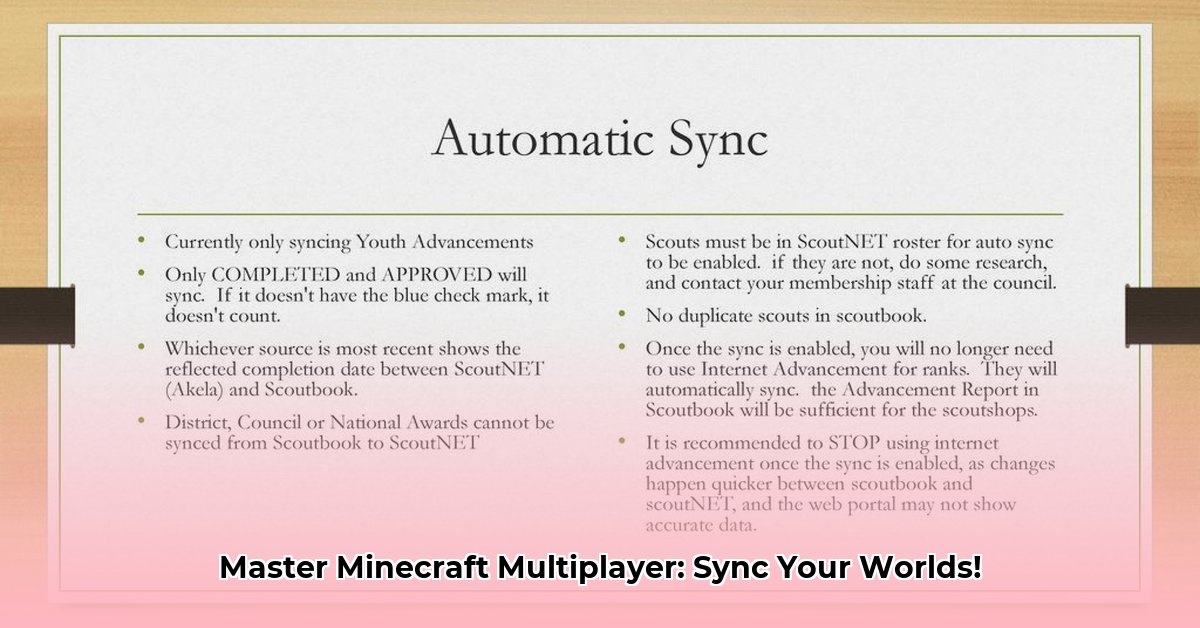Playing Minecraft with friends is an adventure, but uneven progress can disrupt the fun. This guide explores various Minecraft advancement synchronization mods, offering a comparative analysis and practical advice for optimizing your multiplayer experience. Whether you’re a seasoned server administrator or a casual player, this resource will help you choose and implement the perfect synchronization solution.
Choosing the Right Synchronization Mod: A Platform-Based Approach
The first step is selecting the right modding platform: Fabric, Forge, or Spigot. This choice is fundamental, impacting mod compatibility and server performance.
-
Fabric: Known for its lightweight nature and active community, Fabric offers a diverse range of free and readily available advancement synchronization mods. However, community-driven development can sometimes lead to inconsistent updates or varying levels of quality. Its lightweight design makes it ideal for less powerful servers or those prioritizing performance.
-
Forge: A mature and widely adopted platform, Forge often hosts more complex mods with advanced features. This can mean more robust synchronization tools, but potentially at the cost of increased resource consumption. Consider Forge if your server requires extensive customization and can handle the potential performance impact.
-
Spigot: Designed for server administrators seeking granular control, Spigot often provides enterprise-grade tools, sometimes with paid support. This translates to more mature and stable synchronization solutions, ideal for larger server environments. The trade-off can be a steeper learning curve and higher resource requirements.
Here’s a comparative overview of popular advancement synchronization mods:
| Mod | Platform(s) | Custom Advancements | Team Sync | Key Features | Considerations |
|---|---|---|---|---|---|
| AdvancementSync | Fabric/Forge | Yes | No | Simple, lightweight synchronization. | Ideal for basic synchronization; limited features. |
| Cooperative Advancements | Fabric/Forge | Yes | Yes | Robust features, multi-step advancement support. | Requires dependencies (Iceberg); more resource-intensive. |
| SyncedAdvancements | Fabric | Yes | No | Clean, efficient, minimal resource usage. | Fewer features compared to more complex options. |
| HuskSync | Fabric/Spigot | Yes | Yes | Cross-platform, external database support. | Requires technical expertise for setup. |
Choosing the optimal mod involves considering these factors:
- Server Environment: Your existing server setup (Fabric, Forge, or Spigot) is the primary determinant.
- Community Needs: Do you need simple synchronization or team-based progress tracking? Identify essential features for your community.
- Technical Expertise: Evaluate your comfort level with installing and configuring mods, especially those with dependencies.
- Server Resources: Consider your server’s hardware limitations and the potential performance impact of different mods.
- Compatibility Testing: Always test in a non-critical environment to ensure compatibility with other mods and datapacks.
Implementing Advancement Synchronization: A Practical Guide
Installation typically involves downloading the mod JAR file, placing it in your server’s mods folder, and restarting the server. Here’s a detailed example using AdvancementSync (Fabric):
- Download: Obtain the latest AdvancementSync JAR from a trusted source like CurseForge or Modrinth. Verify file integrity and authenticity.
- Installation: Navigate to your Minecraft server’s
modsdirectory. Place the downloaded JAR file into this folder. - Server Restart: Restart your Minecraft server to load the mod. Check server logs for any errors or warnings during startup.
- Verification: Have a player join the server and earn an advancement. Observe if other online players receive the advancement instantly. Consult the mod’s documentation for troubleshooting if synchronization fails.
Addressing Potential Challenges: Proactive Strategies
While advancement synchronization significantly enhances gameplay, some challenges may arise:
- Mod Conflicts: Thorough compatibility testing is crucial. Maintain backups to revert to a stable state if conflicts occur. Consult mod documentation and community forums for known compatibility issues.
- Performance Monitoring: Regularly monitor server performance after mod installation. Optimize server settings or upgrade hardware if necessary. Utilize performance profiling tools to pinpoint bottlenecks.
- Security Best Practices: Download mods exclusively from trusted sources. Stay updated on security vulnerabilities and patch mods promptly. Implement robust server security measures to protect against malicious code.
The Future of Advancement Synchronization: Continuous Evolution
The Minecraft modding community continually pushes boundaries. Expect advancements in synchronization technology, including enhanced compatibility, user-friendly interfaces, and more sophisticated team-based features. Engage with modding communities and forums to stay informed about the latest developments and contribute your own ideas for future innovations.
This enhanced guide equips you with the knowledge to choose, install, and troubleshoot advancement synchronization mods, ensuring a unified and rewarding multiplayer Minecraft experience. By prioritizing thorough planning, testing, and proactive problem-solving, you can cultivate a thriving and synchronized community for all your players.
- Funny Sims 4 Mods Add Wild New Levels of Absurdity - November 25, 2025
- Sims 4 Realism Mods Make Your Virtual Life Truly Authentic - November 24, 2025
- Sims 4 Modpack to Transform Your Game and Storytelling - November 20, 2025










